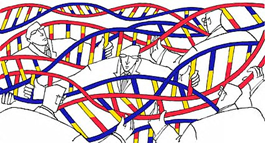Posted 19 April 2018
 Pulmonary arterial hypertension is a rare but serious
disease which affects smaller branches of the pulmonary arteries, which are the
blood vessels which carry oxygen-poor blood from the heart to the lungs to be
re-oxygenated, ready to be pumped back around the body. Currently, half of
people with the condition die within five years of it first appearing, but will
a new genetic discovery lead to earlier diagnoses and therefore a more positive
outlook for those affected? (1, 2, 3)
Pulmonary arterial hypertension is a rare but serious
disease which affects smaller branches of the pulmonary arteries, which are the
blood vessels which carry oxygen-poor blood from the heart to the lungs to be
re-oxygenated, ready to be pumped back around the body. Currently, half of
people with the condition die within five years of it first appearing, but will
a new genetic discovery lead to earlier diagnoses and therefore a more positive
outlook for those affected? (1, 2, 3)
What is pulmonary
arterial hypertension?
Pulmonary arterial hypertension (PAH) is raised blood
pressure in the smaller branches of the pulmonary arteries, caused by the
arterial walls stiffening and thickening. It is difficult for blood to be
pumped through stiff, thick arteries as there is less ‘give’, therefore the
right side of the heart, which supplies the pulmonary arteries, is forced to
pump harder to make sure enough blood reaches the lungs, and blood pressure
rises. This increased workload can weaken the right side of the heart over time
and eventually cause heart failure. (1, 3)
What causes PAH?
A number of pre-existing conditions can be linked to PAH,
including scleroderma (a condition associated with thickened skin, which can
occur in blood vessels), HIV, thyroid problems, sickle cell disease, and
particular medication. However, a cause cannot be established in around 20% of
cases. (1, 2)
What are the symptoms
of PAH?
PAH can cause you to experience shortness of breath, feel
tired, faint or dizzy, experience palpitations (unusually fast or erratic
heartbeat), experience pain in the chest, and develop swelling in the ankles,
feet, legs or abdominal area. Usually, exercise worsens these symptoms.
Unfortunately, contrary to other types of pulmonary hypertension, symptoms
often do not occur until the later stages of the disease, when a lot of the
damage is already done. (1)
How is PAH treated?
If a pre-existing condition has led to PAH, the first step
is to treat this condition if possible. (4)
To treat PAH itself, a range of medicines can be taken
including anticoagulants (such as warfarin),
diuretics, inhaled oxygen therapy, digoxin
(encourages the heart to pump more forcefully whilst lowering heart rate). Sildenafil and tadalafil are primarily used to treat erectile dysfunction but can
be prescribed by specialists to treat PAH. (4)
In severe cases, PAH which is not sufficiently controlled by
medication may call for surgery or a lung transplant. (4)
Unfortunately, PAH cannot be cured, but the treatments may
help to slow, halt or even reverse the progression of the disease to an extent.
(4)
The latest news
An exciting discovery has been made by researchers working
on the 100,000 Genomes Project - four new genetic mutations have been found
that are responsible for causing PAH. Previously, experts knew of only one
mutation linked to the disease. These mutations code for faulty proteins which
are incorporated into tissues including the pulmonary arteries. Knowing about
these mutations opens up the opportunity for more targeted treatments to be
produced in future, and if people with a family history of PAH can be
genetically screened for the condition, it enables earlier diagnosis and earlier
interventions. (2)
References
Author: Gabby Gallagher MPharm
Medically reviewed by: Superintendent pharmacist Margaret Hudson BSc(Hons)MRPharmS 19/04/18
Posted in Men's Health, Womens health